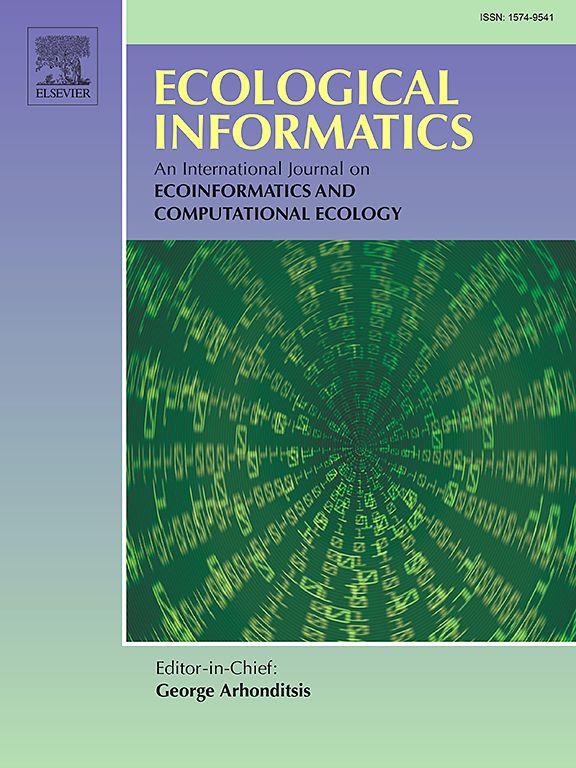Linking morpho-taxonomy to ecosystem functions: Trait-based estimation of biomass and potential carbon budget in omnivore nematodes
IF 5.8
2区 环境科学与生态学
Q1 ECOLOGY
引用次数: 0
Abstract
Omnivore nematodes within the order Dorylaimida are among the largest free-living soil-dwelling nematodes, suggesting a significant role in soil biomass and carbon cycling. However, their contribution to these soil processes remains underexplored. Estimating biomass based on nematode morphological traits provides a practical and reliable approach for assessing their contribution in carbon dynamics. This study provides estimated individual biomass and the daily carbon budget of dorylaimids, utilizing a database of taxon-specific body-size measurements sourced from publicly available literature. We calculated biomass and potential carbon budgets for 618 reported populations worldwide, encompassing 464 species, 127 genera, 47 subfamilies, and 19 families. Biomass estimates derived using body diameter as a sole predictor, based on two recently published formulae and two adjusted formulae developed in this study, were compared with Andrássy's original formula, which incorporates both body length and diameter. The adjusted formulae proposed in this study demonstrated a superior fit compared to the recently published models. Overall, we found an estimated average individual omnivore nematode biomass (fresh weight) of 3.33 μg for females and 3.55 μg for males, and the corresponding daily carbon budgets of 0.03903 μg and 0.04163 μg for females and males, respectively. The considerable variability in biomass data across the taxonomic ranks, highlight the need for robust taxonomic resolution for ecological studies. This study offers a comprehensive dataset and improved formulae for estimating biomass and potential carbon budget in omnivore nematodes, enhancing our understanding of their functional roles in carbon dynamics and other ecosystem processes.

形态分类与生态系统功能的联系:杂食线虫生物量和潜在碳收支的性状估计
Dorylaimida目的杂食线虫是最大的自由生活在土壤中的线虫,表明在土壤生物量和碳循环中起着重要作用。然而,它们对这些土壤过程的贡献仍未得到充分探索。基于线虫形态特征估算生物量为评估其在碳动态中的贡献提供了一种实用可靠的方法。本研究利用来自公开文献的分类单元特定体型测量数据库,提供了dorylaimids的个体生物量和每日碳预算。我们计算了全球618个已报告种群的生物量和潜在碳预算,包括464种,127属,47亚科和19科。基于最近发表的两个公式和本研究开发的两个调整公式,以体径作为唯一预测因子得出的生物量估计值与Andrássy的原始公式进行了比较,该公式包含了体长和直径。与最近发表的模型相比,本研究提出的调整公式具有更好的拟合性。总体而言,雌性和雄性杂食性线虫的平均个体生物量(鲜重)分别为3.33和3.55 μg,相应的日碳收支分别为0.03903和0.04163 μg。生物量数据在不同的分类等级中具有相当大的可变性,这突出了对生态学研究的强大分类分辨率的需求。本研究为估算杂食性线虫的生物量和潜在碳收支提供了一个全面的数据集和改进的公式,增强了我们对杂食性线虫在碳动态和其他生态系统过程中的功能作用的理解。
本文章由计算机程序翻译,如有差异,请以英文原文为准。
求助全文
约1分钟内获得全文
求助全文
来源期刊

Ecological Informatics
环境科学-生态学
CiteScore
8.30
自引率
11.80%
发文量
346
审稿时长
46 days
期刊介绍:
The journal Ecological Informatics is devoted to the publication of high quality, peer-reviewed articles on all aspects of computational ecology, data science and biogeography. The scope of the journal takes into account the data-intensive nature of ecology, the growing capacity of information technology to access, harness and leverage complex data as well as the critical need for informing sustainable management in view of global environmental and climate change.
The nature of the journal is interdisciplinary at the crossover between ecology and informatics. It focuses on novel concepts and techniques for image- and genome-based monitoring and interpretation, sensor- and multimedia-based data acquisition, internet-based data archiving and sharing, data assimilation, modelling and prediction of ecological data.
 求助内容:
求助内容: 应助结果提醒方式:
应助结果提醒方式:


